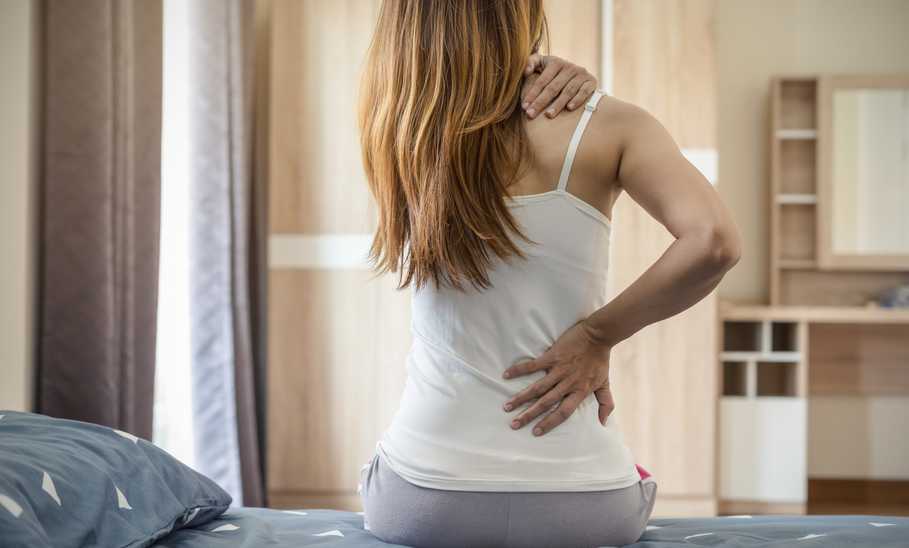Chronic back pain is a huge obstacle to overcome when you’re trying to get a good night’s sleep. If you’ve ever dealt with this type of discomfort, you’ll do just about anything to get comfortable. The bed you’re sleeping in all night can make or break the situation. Having the right mattress to align and cradle your body can mean the difference between waking up refreshed and waking up in agony.
Back pain and sleep directly impact one another, says Dr. Staci Hildebrandt, PT, DPT, OCS, who works at ProRehab in Henderson, Kentucky. “A lack of good sleep can increase the pain experienced by not allowing our body and brain to get the correct duration and depth of rest to reset and heal,” explains Hildebrandt. “And back pain can make it hard to get comfortable getting to sleep and staying asleep.”
There are certain factors to keep in mind when shopping for a mattress that’ll go easy on your back, and you don’t even have to test out the mattresses in person if you know what to look for. We’ve analyzed the best mattresses for back pain based on firmness, support, quality, construction, and even different sleep styles, and compiled the standouts into one convenient list for you. We also made sure to pick mattresses at a variety of price points so that everyone dealing with back pain at night can find some sweet relief.
Our top picks for the best mattresses for back pain
Most comfortable mattress for back pain: Helix Midnight

Helix Midnight
Helix’s comfy hybrid mattresses are known for customized and adaptive comfort. The company offers a wide range of mattresses and prices, but the highly heralded Helix Midnight checks many boxes, making it our vote for the most comfortable mattress for people suffering from back pain.
Although the Helix Midnight is recommended for side sleepers, it could work for many sleep positions thanks to its adaptive foam layers, medium firmness (not too hard and not too soft), and deep pocketed coils to support your back. You can even upgrade some of the basic features, like adding a cooling cover.
You can also choose between two hypoallergenic top fabrics: A 100% poly cover or a 50/50 cooling cover (polyester and polyethylene) for overheated sleepers. You can also upgrade to the Helix Midnight Elite, which offers Helix’s most advanced support system, with zoned lumber support and full perimeter reinforcement.
If you’re not a side sleeper, Helix offers other models for stomach and back sleepers with similar technology and comfort, designed to help ease muscle pains and ensure a great rest, day or night. Plus, if you’re unsure which mattress to purchase to help protect and care for your back, you can take Helix’s sleep quiz to discover your best fit.
Helix offers financing, free returns, a 100-night sleep trial period, and a 10-year warranty.
Specifications
- Price: Starting at $936
- Type: Memory foam, dynamic foam, hypoallergenic top fabrics, and high-grade polyfoam
- Trial: 100 nights
- Delivery: Delivery available
- Warranty: 10-year warranty
- Firmness: Multiple options
Pros:
- Offers comfort for side sleepers.
- Affordable pricing and upgrades.
- Made in the USA.
- All mattresses have a layer of zoned, wrapped coils that the company states “provide greater support, durability, airflow, and edge-support” for sleepers.
Cons:
- Elite versions of Helix mattresses are costly.
The bottom line:
A hybrid mattress designed for side sleepers that’s supportive and comfortable enough for other positions, too.
Best hybrid mattress for back pain: Bear Elite Hybrid
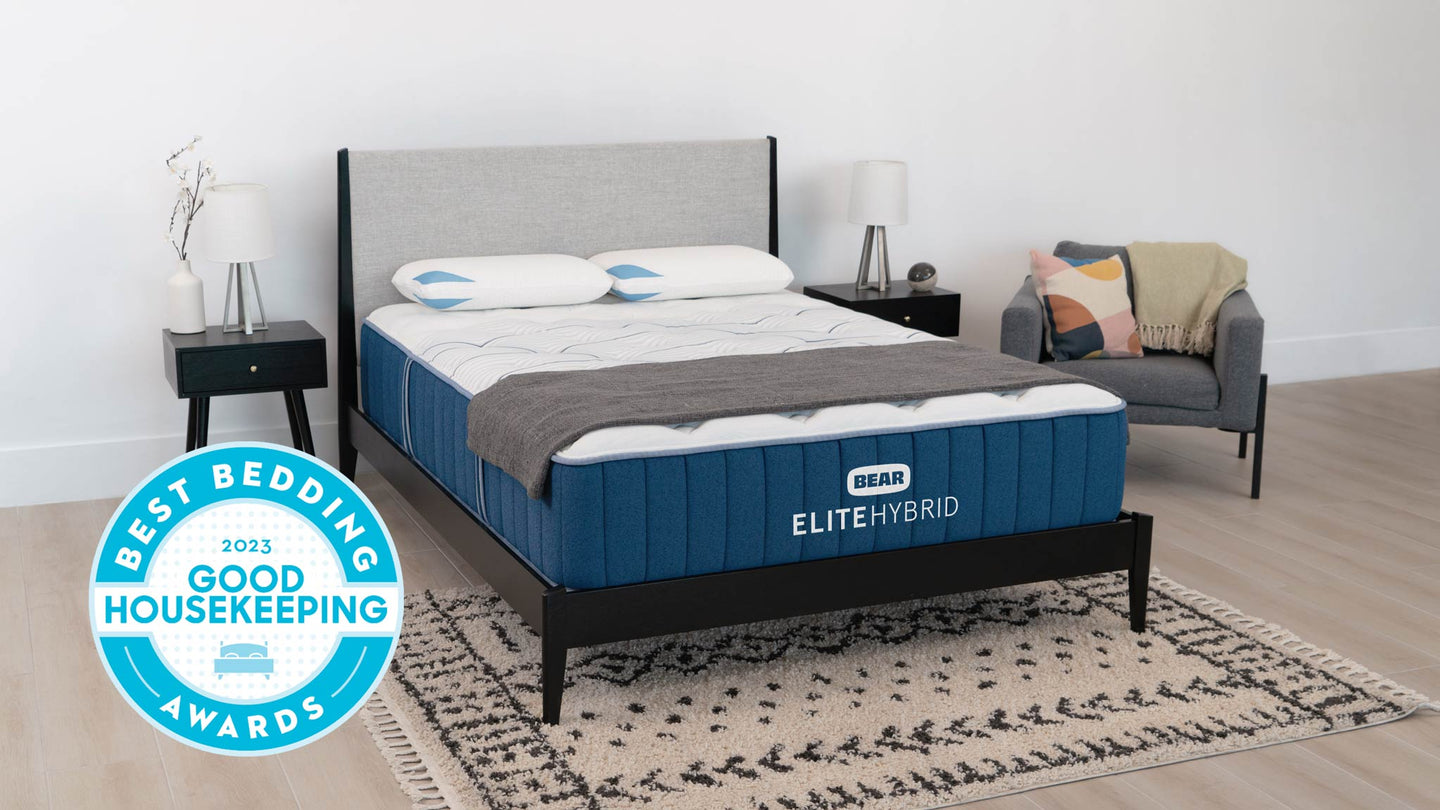
Bear Elite Hybrid
Increasingly popular, hybrid mattresses take the best of traditional, innerspring mattresses and more modern materials to create something with a perfect balance of support and give. Our pick for the best hybrid mattress for back pain is the Elite Hybrid from Bear.
Let’s start at the top, literally: The mattress is topped with a phase change material (PCM) that’s designed to absorb your body heat, giving you a cooler night’s sleep. This rests on top of a layer of copper-infused memory foam, which also helps to disperse unwanted heat, while also having antibacterial properties to ensure a healthier rest.
Beneath this lies a thick layer of dynamic transition foam, both for comfort, and to help your body weight ease into the next, and largest, layer, which is made up of individually encased spring coils. This zoned system is designed to provide lumbar support in the center, where it’s needed most, but since each spring responds individually, you’ll find that it has the right amount of give for each part of your body.
Finally, at the base, is a layer of high density support foam, designed to give the mattress better overall stability.
The Elite Hybrid also comes with a lifetime warranty and a 120-night trial period, so you’ve really got time to settle in and see how it suits you.
Specifications
- Price: Starting at $1,231
- Type: Hybrid
- Trial: 120 days
- Delivery: Free
- Warranty: Lifetime
- Firmness: Medium
Pros:
- Has cooling and anti-bacterial properties
- Mixed layers of foam and springs provide both comfort and support
- 120-day trial period
- Free deliveries and returns
- Lifetime warranty
Cons:
- Expensive
- May not be firm enough for some people
The bottom line:
A high-tech, high-comfort hybrid mattress suitable for multiple types of sleeping position.
Best firm mattress for back pain: Plank Firm Luxe
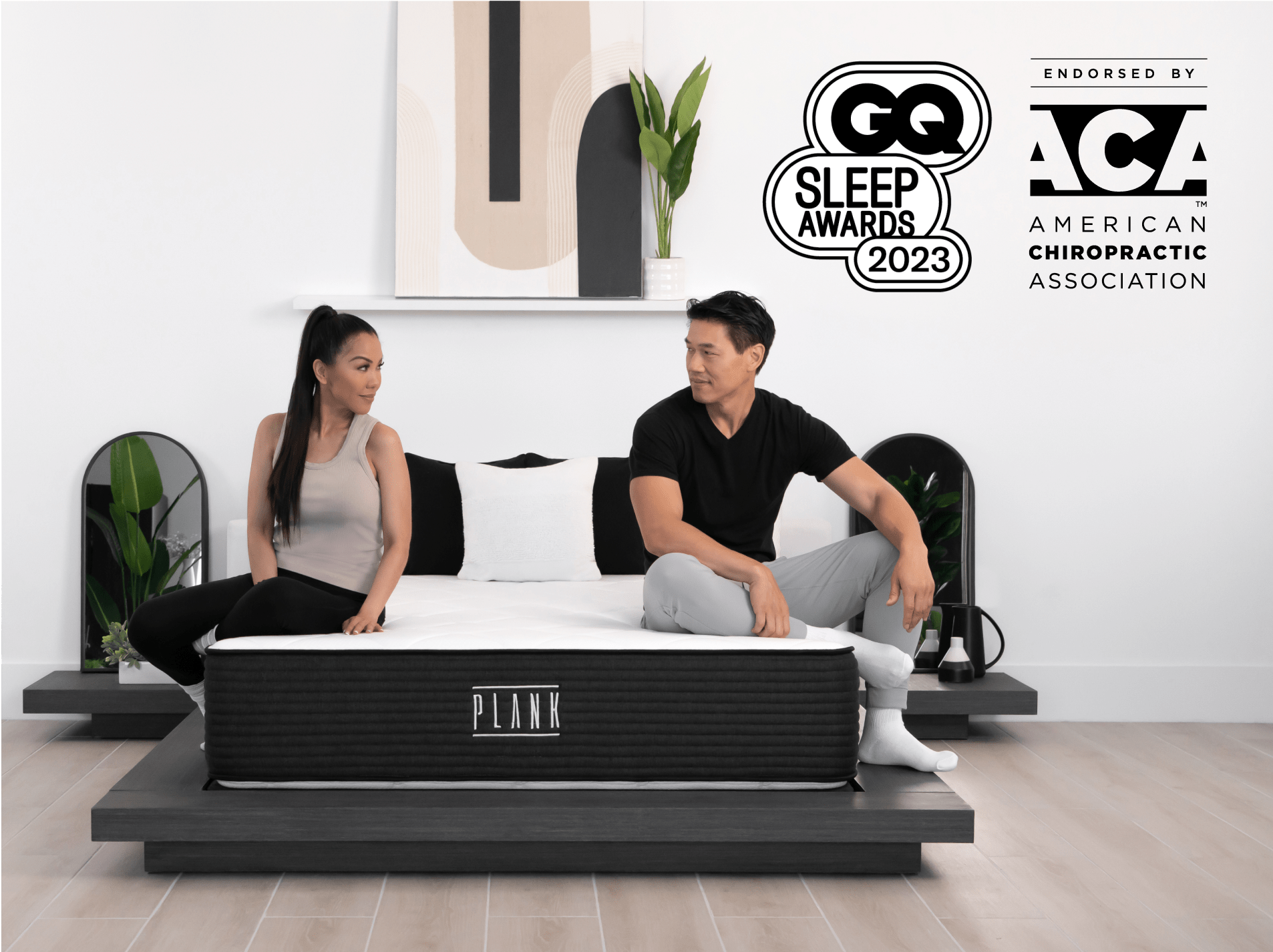
Plank Firm Luxe
Of all the mattress categories, firm seems to be the one with the most “your mileage may vary” to it, with customer review sections of many firm mattresses arguing over what exactly constitutes “firm.” But if there’s one mattress we can confidently say will work for those needing serious firmness, it’s the Plank Firm Luxe.
The regular Plank Firm made our list of the best firm mattresses, thanks to its thick, high-density foams and combination of extra firm feel and give where appropriate. The Luxe builds on this model, featuring a zero-loft cover (or optional GlacioTex cooling cover, if you feel like shelling out a little extra), a two-inch layer of high density support foam, six inches of individually encased firm coils, another two-inch layer of high-density foam, and an inch of supreme response comfort foam.
Best of all, you get two mattresses for the price of one, since it’s flippable. One side (the one with the comfort foam closest to the surface) is firm, coming in at a 7/10 on their firmness scale, while the other side is even firmer, scoring a 9/10.
Specifications
- Price: Starting at $693
- Type: Hybrid
- Trial: 120 nights
- Delivery: Free
- Warranty: 10 years
- Firmness: Firm or very firm
Pros:
- Flippable
- Firmer than most “firm” mattresses
- Optional cooling cover
- American Chiropractic Association-approved
- 120-night trial period
- Free delivery
Cons:
- Firmness might be too much for some people
- Some customers felt it was a little high for their needs
The bottom line:
A seriously firm mattress with the option of going even firmer by flipping it over.

Brooklyn Bedding Aurora Luxe Cooling
Trying to sleep with back pain is bad enough. If you also run hot at night and find it hard to cool down, that’s even worse. To find a mattress that helps with both issues, consider Brooklyn Bedding’s Aurora Luxe Cooling model.
Designed for keeping you cool, the mattress starts with a GlacioTex cooling cover, which helps to dissipate heat. Beneath that is a layer of antimicrobial PCM foam to help with thermal regulation, followed by two inches of supreme response comfort foam. Under that is a layer of cooling gel-infused memory foam, resting atop eight inches of coils, which offer both supportiveness and air flow. Underneath all of that is a .75-inch layer of high density base foam, for added stability.
In terms of helping your back, you get to decide what’s best–the mattress is available in either soft, medium, or firm options, so you can go for whatever is going to help the most. You also get 120 nights to decide, as well as free delivery.
Specifications
- Price: Starting at $899.30
- Type: Hybrid
- Trial: 120 nights
- Delivery: Free
- Warranty: 10 years
- Firmness: Optional
Pros:
- Lets you choose between soft, medium, and firm
- Stuffed with cooling technology
- Option to add a Cloud Pillow Top for extra softness
- Comfortable but supportive
Cons:
- Several customers comment on how high the mattress is
The bottom line:
A mattress designed for helping hot sleepers cool down, available in multiple firmness options.
Best for stomach sleepers with back pain: Leesa Original

Leesa Original
20% offSave $300
Stomach sleepers with back pain: You’re going to love the Leesa Original. This all-foam mattress features a breathable cover, under which lies a top layer of comfort foam, a memory foam recovery layer, and finally a large foam stability layer. This all adds up to a mattress that’s extremely comfortable, while still having enough support to be suitable for stomach sleepers, who generally require more support to stop them from sinking into the mattress.
Leesa mattresses have the added bonus of being environmentally friendly, as their mattresses are made of natural and recycled materials. They’re also Greenguard Gold and Certi-PUR US certified, so you can be reassured that there are no harmful chemical emissions.
All in all, the Leesa Original is a sweet dream for stomach sleepers battling back pain.
Specifications
- Price: Starting at $637
- Type: Memory foam
- Trial: 100 nights
- Delivery: Free
- Warranty: 10 years
- Firmness: Medium
Pros:
- Has excellent quality and design
- Is great for stomach sleepers
- Multiple layers of different density foams for the ideal blend of comfort and support
- 100-night free trial
- Free delivery
- Affordable
Cons:
- Some customer reviews say it runs a little hot
The bottom line:
An all-foam mattress with the right combination of softness and support for stomach sleepers.
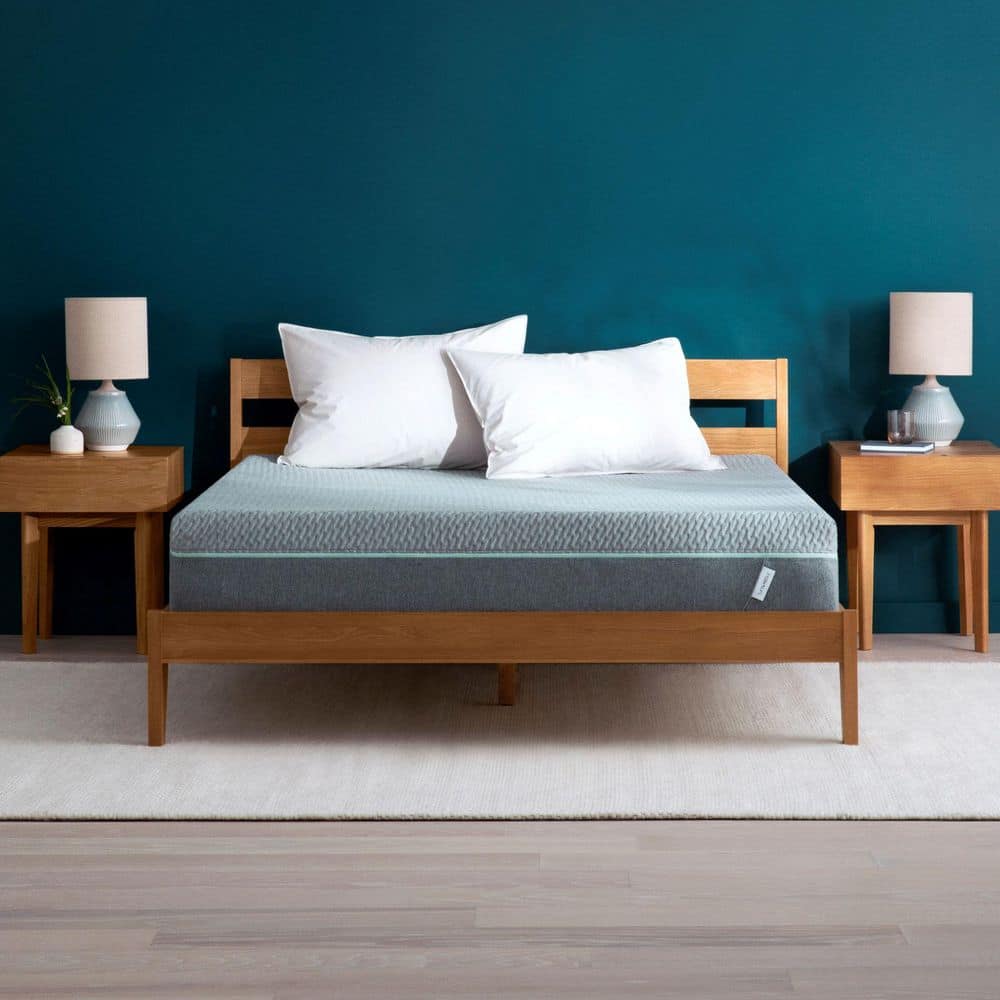
Tuft Needle Adaptive Foam
Designed to be compatible with most bed frames, the Tuft & Needle Adaptive Foam mattress conforms to your body at every level, which can relieve pressure from your back as well as your hips and neck. It was developed based on the feedback of real customers.
All Tuft & Needle mattresses are made with Adaptive foam, which is specially designed to respond to your body and provide pressure relief without trapping heat and creating body impressions like memory foam or costing a ton like latex.
No matter if you’re a back sleeper, side sleeper, or stomach sleeper, the Tuft & Needle Adaptive Foam mattress moves with you to support perfect alignment all night long.
Tuft & Needle mattresses include breathable cooling technology infused with cooling gel and graphite to transfer heat away from your body, so you won’t wake up in the middle of the night or make your back pain worse by tossing and turning.
Tuft & Needle offers a 100-night trial and free returns. They report that 95% of their customers keep their Tuft & Needle products, which should put your mind at ease!
Specifications
- Price: Starting at $745
- Type: Memory foam
- Trial: 100 days
- Delivery: N/A
- Warranty: 10 years
- Firmness: Firm
Pros:
- Has cooling properties.
- Combines best features of memory foam and latex.
- Great for all types of sleepers
- Is compatible with most bed frames.
- Is free of harmful chemicals.
- Offers 100-day trial and free returns.
- Price point offers value.
Cons:
- Very firm.
- Doesn’t offer free delivery.
The bottom line:
A fantastic all-rounder mattress that will work for most sleeping positions.
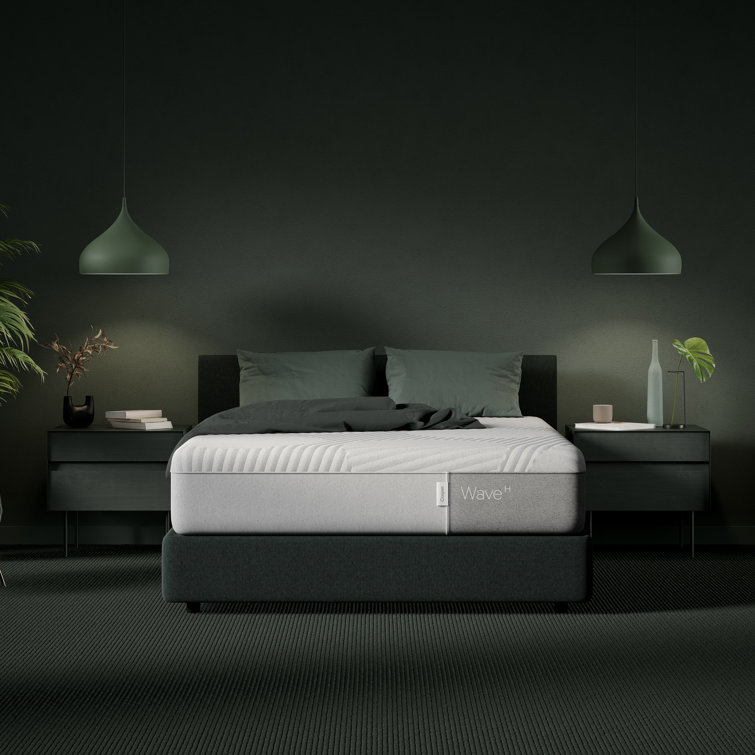
Casper Sleep Wave Hybrid Mattress
Side sleepers seeking a supportive mattress will find comfort in the Casper Wave Hybrid, which is designed to keep your spine aligned. Nine out of 10 buyers have reported that the Wave Hybrid eased their back pain, according to Casper.
The key to Casper Wave Hybrid’s success is its Zoned Support Max (a mix of Align foam and gel pods) that lift your waist and lower back to keep your body in alignment while you sleep on your side, instead of allowing your hips to sink like other mattresses might.
With Casper’s AirScape material, thousands of perforations in the breathable foam offer proper ventilation so you stay cool all night.
The mattress features premium memory foam that conforms to your body to absorb pressure and a durable base foam that offers long-lasting support. This allows for better cradling of your entire body. It also includes resilient springs that provide additional support, prevent sinking, and let air circulate.
All Casper mattresses are made with CertiPUR-US certified polyurethane foam, which means the Wave Hybrid is made without ozone-depleting chemicals, so you can rest easy. The Casper Wave Hybrid also comes with free, no-contact delivery, free shipping, a 100-night risk-free trial, and a 10-year warranty.
Specifications
- Type: Memory foam
- Trial: 100 nights
- Delivery: Free
- Warranty: 10 years
- Firmness: Firm
Pros:
- Has zoned support to keep your waist and lower back aligned.
- Features patented cooling design.
- Is a hybrid of memory foam and springs.
- Uses CertiPUR-US certified polyurethane foam materials.
Cons:
- Expensive.
- May be too firm for those under 130 lbs.
The bottom line:
A hybrid mattress made to keep you comfortable and your spine aligned.
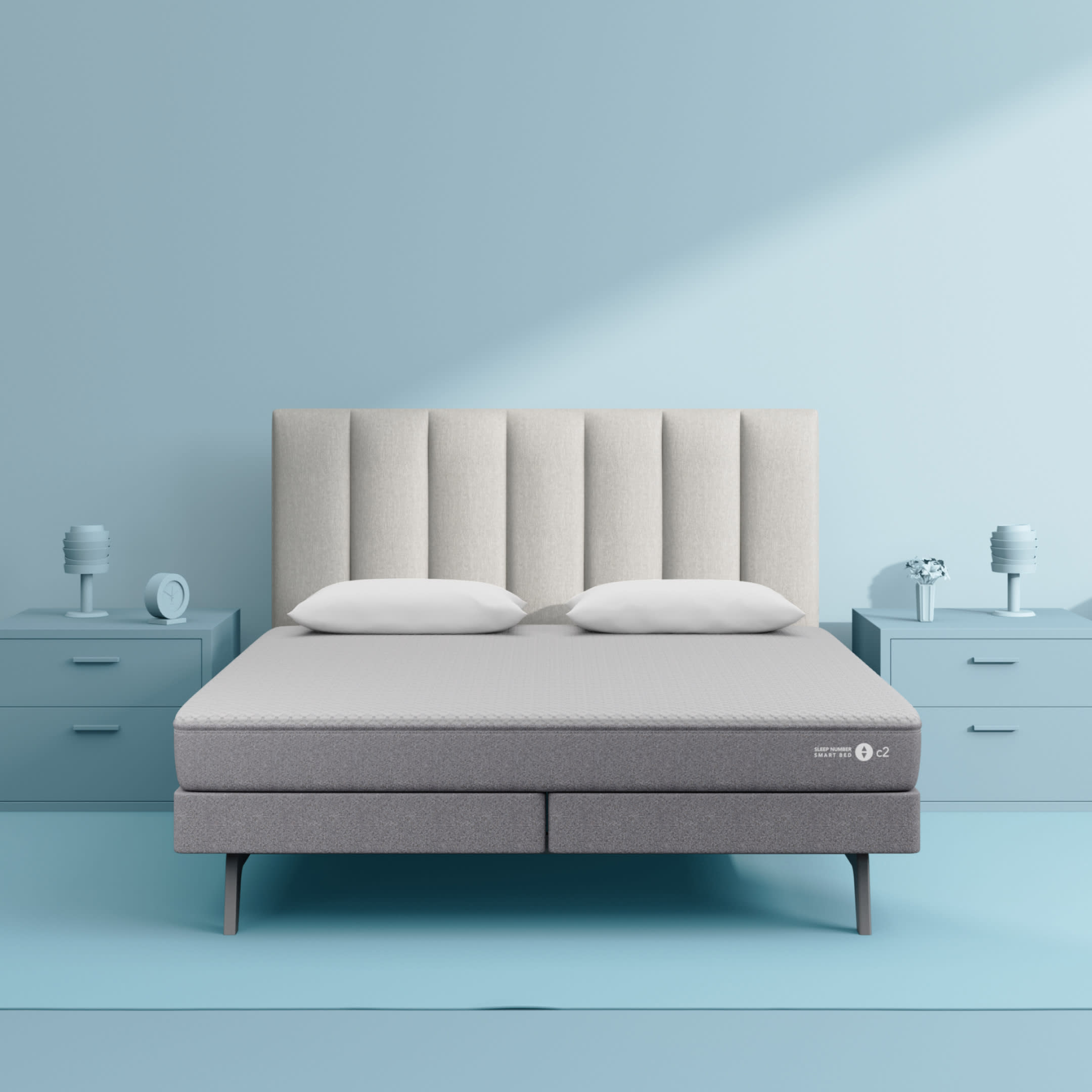
Sleep Number 360 c2 Smart Bed
Sleep Number beds are known for their luxurious sleep experience and customized firmness for yourself and the person sleeping next to you. The Sleep Number 360 C2 is a high-end option for sleepers with back pain at a relatively affordable price point, making this also one of the best adjustable mattresses.
The Sleep Number 360 C2 actively adjusts itself to your needs—and, as someone with back pain, I know those may change from night to night. Not only does it respond to your movements and automatically adjust firmness on each side, but it also displays sleep quality—known as your SleepIQ® score—on the brand’s accompanying SleepIQ® app along with personal insights for better sleep. Once you know your Sleep Number, you’ll always know how to set your mattress to best support your back pain.
The C2 also has little motion transfer. This means you’re less likely to be bothered if your partner tends to toss and turn at night. This mattress is a great option for people who love firm beds, especially side sleepers.
The Sleep Number 360 C2 is the most basic of the Sleep Number collection, and its simplicity is reflected in its reasonable price. Yes, you can experience the back-soothing bliss of a luxury mattress without a high ticket price.
Sleep Number offers a 100-night trial and free returns.
Specifications
- Price: Starting at $699
- Type: Rayon and polypropylene fabrics
- Trial: 100 nights
- Delivery: Delivery available
- Warranty: 25 years
- Firmness: Multiple options
Pros:
- Offers customized firmness for two sleepers.
- Responds to your movements.
- Customizes your experience via a companion app.
- Has low motion transfer.
- Offers 100-day trial.
- Has a great price.
Cons:
- Has no foam topper above air compartments.
- Needs an electric source to use all amenities.
The bottom line:
A high-tech, high-end mattress without the sticker shock you might be expecting.

Tempur-Pedic Tempur-Adapt
Tempur-Pedic specializes in lumbar support, which is why we chose the Tempur-Pedic Tempur-Adapt mattress as our choice for the best lumbar support mattress. Tempur-Pedic uses a top-of-the-line material that’s unique to the brand, but was developed by NASA. If you’re dealing with lower back pain, you can’t do much better than this. The layers of this special foam work together to support your body and relieve pressure. One of our editors, who had a severely herniated lumbar disc, says Tempur-Pedic is by far the most comfortable mattress brand she’s tried.
The Tempur material is a truly custom experience, responsive to every feature of your body including your temperature, and the Adapt technology fully absorbs your weight and pressure points, so the motion isolation is also exceptional. That means you can get a good night’s sleep even if your partner is tossing and turning.
The Tempur-Pedic Tempur-Adapt is compatible with most bed frames, except for a traditional box spring or when placed on the floor. This interferes with the pressure point absorption, and the mattress will not perform optimally.
When it comes to addressing back pain and lumbar alignment, the Tempur-Pedic Tempur-Adapt is the absolute best on the market right now.
Specifications
- Price: Starting at $2,899
- Type: Polyurethane foam and wrapped steel coils
- Trial: 90 nights
- Delivery: Free delivery
- Warranty: 10 years
- Firmness: Soft
Pros:
- Offers superior pressure relief and responsiveness.
- Has a strong reputation for reducing back pain.
- Has excellent motion isolation
- Has cooling properties.
Cons:
- Carries a high price that matches its superior construction.
The bottom line:
Those seeking both pressure relief and lumbar support will rest easy on this high end (but admittedly pricey) mattress.
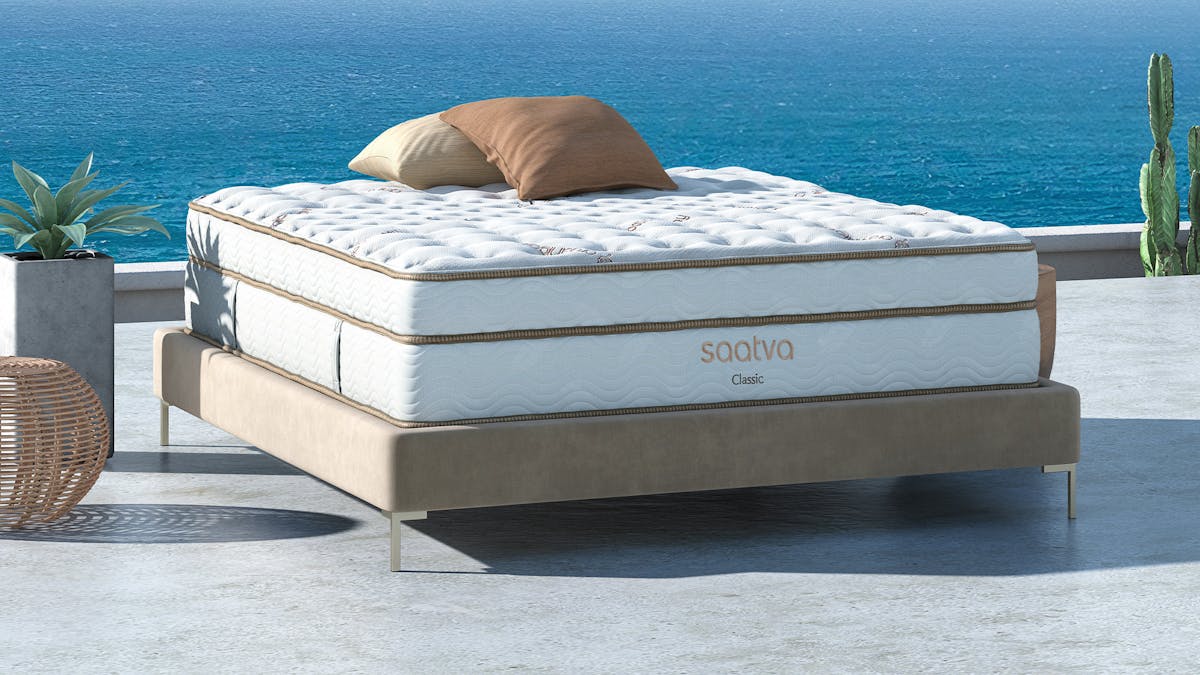
Saatva Classic Mattress - Queen
The best firm mattress for sleepers who require extra support for their back and body pain is the Saatva Classic mattress. It combines the guaranteed support of an innerspring system with the cushy comfort of foam. Its recycled carbon steel coils have been tempered three times for resilience.
Lumbar Zone® Technology supports your spine and keeps it in alignment no matter what sleep position you’re in.
The Saatva Classic adds a plush top that many other memory foam or hybrid beds don’t offer—a nice, marshmallowy treat in the world of sometimes overly flat foam mattresses. This plush top may help support your body and eliminate discomfort by contouring to your individual shape while supporting your head and neck.
Sleepers who prefer a firm mattress will love the support of the Saatva Classic mattress, designed to feel sturdy and responsive so that they never feel they’re sinking into or sliding off the mattress. This is important if a lot of movement irritates your chronic pain.
It’s also one of the few innerspring mattresses you can conveniently buy online.
Saatva offers a 365-night trial and a lifetime warranty.
Specifications
- Price: pre-discount starts at $1095
- Type: Innerspring and memory foam
- Trial: 365 nights
- Delivery: Free delivery
- Warranty: Lifetime
- Firmness: Firm
Pros:
- Offers superior pressure relief and responsiveness.
- Has a strong reputation for reducing back pain.
- Has excellent motion isolation
- Has cooling properties.
Cons:
- Carries a high price that matches its superior construction.
The bottom line:
A mattress firm enough to give you the support you need, but with enough give for a comfortable night’s sleep.
How we evaluated the best mattresses for back pain
We first spoke to experts who offered advice on what those with back pain should consider when buying a mattress. We then analyzed the main buying and usage considerations for consumers when rating these mattresses for each specific category. The main points we researched were:
- Firmness: The firmness of a mattress is a main concern for most people because it affects their comfort, especially when dealing with back pain. We wanted to touch upon mattress firmness for each selection.
- Composition: The composition of a mattress will determine the way it supports different body types and sleep styles.
- Sleep style: Sleep style is a main determinant of the type of mattress you’ll buy. It was important to include it within our choices.
- Cost: Price is a main concern for buyers and we wanted to share a variety of price points to fit into your budget.
How to choose the right mattress for back pain
Firmness level
Hildebrant says that if you’re experiencing back pain, you should look for a mattress with medium-firm support. “This is the kind of mattress that has been shown with research to support improved comfort, sleep quality, and alignment with sleep,” she says.
Physical therapist Marius Hernandez, D.P.T., based in Woodbridge, Va., agrees that a medium-firm mattress may be best for a bad back. “Studies have shown that medium-firm mattresses, adjustable inflation, and adjustable temperature may improve pain and disability among patients with chronic non-specific low-back pain,” he says. Overall, just paying attention to the right kind of mattress for your individual needs is important. “The type of mattress can affect comfort, alignment, and quality of sleep and hence help to decrease the pain, so it is important to have the right type of mattress.”
Materials
“When choosing a mattress for back pain, consider memory foam or latex for pressure relief,” suggests Dr. Shelby Harris, licensed clinical psychologist and board certified sleep specialist. “It's important to prioritize finding a mattress that provides proper spinal alignment and good body support while laying down.”
Your doctor’s advice
It never hurts to ask your trusted doctor or physical therapist to make bedding recommendations based on your personal physical profile—indeed, Shelby recommends doing this if you’re experiencing regular back pain.
Price
Most mattresses that are good for helping with back pain may run towards $1,000 or more, although we have a few on our list that are under $700. If you’re on a tight budget, many companies offer sales over Black Friday, Memorial Day weekend, and other shopping-related holidays. See our guide to the best time to buy a mattress for more.
Returns
Check to make sure the seller offers returns or even a sleep trial run that allows you to try out your new mattress before you commit.
Sleep style
Some mattresses are created for certain body positions, like side sleepers versus those of us who sleep on our stomachs. It may be worth exploring mattresses designed for particular sleep styles, if you’re concerned about your comfort.
Hildebrandt recommends doing what you can to alter your individual position while sleeping. “Most of the time, with those with low back pain, I tend to recommend lying on their back with pillows under their knees or lying on their side with a pillow between their knees and hugging a pillow with their top arm,” she says.
Ultimately, while your sleep style may influence the type of mattress you find comfortable, there is no one-size-fits-all mattress, according to Hernandez. “Each individual has different needs and preferences, but if someone selects the wrong mattress, they will likely experience pain and notice a big difference when they change to a different mattress that alleviates their symptoms.”
Types of back pain and my mattress
“Different types of back pain may need different mattresses,” says Harris. Here, she breaks down some of the differences:
Lower and mid back pain
Those with lower and mid back pain know all about trying to sleep with that dull ache chewing away at you. To combat it, a firmer mattress is likely best, ideally made from something that will contour to your body somewhat to promote spinal alignment. “People with lower and mid-back pain might like medium-firm mattresses with support, like memory foam or hybrids,” says Harris.
Upper back pain
Those with upper back pain will often also find a firmer mattress to be beneficial, but it’s important for your mattress to retain some give, especially around the neck and shoulders. “For upper back pain, a medium-firm mattress with cushioning around the shoulders could help, like memory foam or latex,” says Harris.
Neck pain
Neck pain is a tricky one, since it’s likely to come down to a mix of mattress and pillow choices, as well as your sleeping position. If you’ve already chosen the best pillow for neck pain, it’s time to look at your mattress. “People with neck pain might find relief on a medium-firm mattress that aligns the spine, such as memory foam or latex,” says Harris. “Testing mattresses and asking doctors for advice are important when it comes to finding the right one for you.”
Sleeping position and back pain
“Depending on how you sleep, different parts of your body might feel pressure on certain mattresses,” says Harris. She has the following advice for common sleeping positions, saying that, “These tips can help you pick a mattress that reduces pressure and keeps your spine comfortable, but everyone's preferences are different!”
- Side sleepers: Try a medium to medium-soft mattress to cushion the sleeper’s shoulders and hips while still keeping the spine in alignment.
- Stomach sleepers: Since stomach sleepers might feel pressure on their hips and chest, a firmer mattress–so that they don’t sink in as much–would be best.
- Back sleepers: To avoid feeling so much pressure on the lower back and head, a medium to medium-firm mattress should keep your body in proper alignment.
Which types of mattresses are best for back pain?
In general, a mattress that’s firm enough to support your body and keep your spine aligned, but soft enough to let you sleep comfortably and cushion pressure points like the hips and shoulders, is ideal. Look for materials that best suit your specific needs: “Memory foam molds to your body and relieves pressure, while latex provides support and conforms to your shape,” says Harris. “Hybrids combine different materials for support and softness. Innerspring mattresses with pocketed coils offer support and adaptability. Adjustable air mattresses allow you to change their firmness. Everyone's preferences differ, so finding the best mattress for back pain means considering what feels comfortable in terms of firmness and material for you.”
Can my mattress cause back pain?
“Absolutely!” says board-certified family medicine physician Dr. Laura Purdy. “If you’re sleeping on a mattress that’s too soft and doesn't support you, this can cause back pain. There are also specific mattresses that are ideal for certain sleep positions, so if you have a preferred sleep position, it's best to look for a mattress that supports how you specifically sleep.”
Sleep tricks to reduce back pain
“Stretch and move your body before bed!” says Purdy. “If you are going to bed stiff, then chances are you’ll wake up feeling worse.”
“Try using a pillow between your knees if you sleep on your side, or under your knees if you sleep on your back,” advises Harris. “Before sleeping, try using a hot or cold pack to relax your muscles and provide pain relief. If your back pain doesn't improve, it's smart to talk to a doctor for advice.”
Frequently asked questions (FAQs)
What mattress do doctors recommend for back pain?
This one really depends on your specific needs. “A mattress is an investment, so I would go test some mattresses out, keeping all of these tips in mind,” says Purdy. “Everyone sleeps differently and has different preferences, so finding the perfect match for you and your sleep needs is ultimately personal preference when it comes to finding the right brand.”
Is a stiff or soft mattress better for back pain?
“For back pain, an extremely stiff or extremely soft mattress isn't usually the best choice,” says Harris. “Too stiff and it might not follow your body's shape, too soft and it might not give enough support. It’s common to suggest a middle ground, i.e., a medium-firm mattress. This will offer a balance, supporting your spine while still contouring a bit to your body for comfort. But what's best can differ for each person, so trying out different mattresses is important to find what feels right for your back.”
“If you’re concerned that a firm mattress will not be comfortable enough, you can try using a topper for extra comfort,” adds Purdy. You can see our picks for the best mattress toppers for back pain here.
What type of mattress should I avoid for back pain?
“For back pain, steer clear of mattresses that are super hard or extremely soft,” reiterates Harris. “Really firm ones might not let your body sink in comfortably, while very soft ones might not give enough support. Also, avoid mattresses that are old, saggy, or don't offer good support—they can make back pain worse. Aim for a mattress that's in the middle, not too hard or too soft, to help ease back pain.”
How do I know if my mattress is causing my back pain?
It might sound obvious, but if your back hurts more during or after sleeping than it does during the day, your mattress might well be to blame. “Your mattress might be causing your back pain if you wake up feeling stiff or sore, notice visible wear like sagging or lumps, or find relief when you sleep elsewhere,” says Harris. “If you experience a reduction in back pain after getting out of bed or if your mattress is older than seven to ten years, it could also be a contributing factor. Testing out different sleeping surfaces or trying a new mattress might help determine if it's causing your discomfort.”
Is memory foam bad for your back?
“Memory foam mattresses aren't necessarily bad for your back,” says Harris. “They can help by molding to your body and aligning your spine. But for others, they might feel too soft or lack enough support. Also, memory foam can get warm, which might be uncomfortable if you sleep hot. Whether memory foam works for your back depends on how well it supports you and your spine and if it feels comfy for you. Trying out different mattresses can help find what suits you best.”
